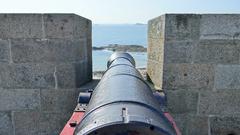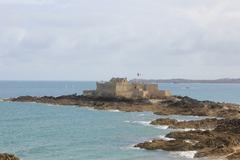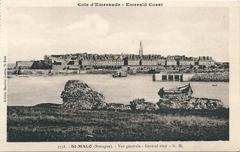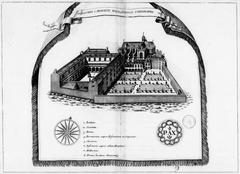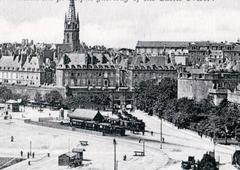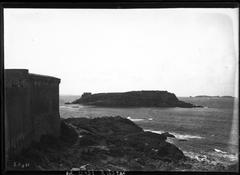Saint-Malo Cathedral: Complete Guide to Visiting Hours, Tickets, History, and Highlights
Date: 15/06/2025
Introduction
Saint-Malo Cathedral (Cathédrale Saint-Vincent-de-Saragosse de Saint-Malo) stands as a monumental testament to the city’s enduring spirit, rich history, and diverse architectural heritage. Nestled within the fortified walls of Saint-Malo in Brittany, France, this cathedral has witnessed nearly a millennium of transformation—from its 12th-century Benedictine monastic origins, through Gothic and Renaissance expansions, to neoclassical and modern restorations. Today, it serves as both a spiritual center and a symbol of resilience, especially following its destruction and subsequent restoration after World War II (The Introvertraveler; Spotting History; fr.wikipedia.org).
This comprehensive guide covers everything you need to know for your visit: detailed history, architectural highlights, hours, admission, accessibility, tips for visitors, and nearby attractions.
Brief History and Significance
The cathedral’s origins trace back to the 12th century, when the episcopal seat was transferred from Aleth to the safer, more strategically located promontory of Saint-Malo. Its foundations rest on an earlier Benedictine site, and the city itself is named after the Welsh monk Maclovius (Saint Malo), who became its first bishop in the 6th century (The Introvertraveler; saint-malo-tourisme.com). Over the centuries, the cathedral evolved through Romanesque, Gothic, Renaissance, and neoclassical phases, each leaving a unique mark.
During World War II, severe bombing left the choir and much of the stained glass in ruins. A meticulous twenty-year restoration followed, blending historic preservation with modern artistry (Spotting History; europeupclose.com).
Today, Saint-Malo Cathedral is a living monument—hosting religious ceremonies, civic events, concerts, and serving as a site of remembrance and cultural pride.
Architectural Highlights
Romanesque and Gothic Foundations
The earliest sections, including the nave and transept, are Romanesque, identifiable by rounded arches and thick stonework. From the 13th to 15th centuries, Gothic elements were added—most notably the choir, chapels, and soaring ribbed vaults. The pointed arches, flying buttresses, and intricate window tracery illustrate the transition to the High Gothic style (fr.wikipedia.org).
Renaissance, Neoclassical, and 19th-Century Enhancements
Renaissance and neoclassical interventions in the façade and chapels introduced new decorative motifs and proportions. In the 18th century, architect Robert Verron rebuilt the façade in a restrained neoclassical style (fr.wikipedia.org). The iconic openwork spire, inspired by Breton traditions, was added in the 19th century and rebuilt after WWII (letour.fr).
Stained Glass and Interior Artistry
One of the cathedral’s most celebrated features is its stained glass, particularly the post-war windows by Jean Le Moal and Bernard Allain, which bathe the choir in colored light. A prominent rose window and a figurative panel illustrating Bishop Jean de la Grille blessing Jacques Cartier (the explorer who claimed Canada for France) are among the highlights (europeupclose.com; The World Pursuit).
Sculptural treasures include an 18th-century marble Madonna and Child, historic choir stalls, and the Renaissance tomb of Bishop Thomas James. The tomb of Jacques Cartier remains a focal point, drawing history enthusiasts and pilgrims alike (saint-malo-tourisme.com).
Visiting Saint-Malo Cathedral
Location and Access
- Address: Place de la Croix, 35400 Saint-Malo, France (The Tourist Checklist)
- Located within Intra-Muros, the walled city, the cathedral is a short walk from the main gates and nearby public parking. The 72-meter spire is a landmark, visible from the ramparts and harbor (Monsieur de France).
Opening Hours
- April–October: 9:30 AM – 6:30 PM
- November–March: 10:00 AM – 5:00 PM
- Hours may vary due to religious services or special events (The Tourist Checklist; solosophie.com).
Tickets and Admission
- Admission: Free of charge; donations welcome.
- Guided Tours: Available seasonally in French and English, bookable through the tourist office or at the cathedral. Some special exhibitions or audio guides may require a small fee (Simply France).
Accessibility
- The main entrance has steps, but ramp access is available at a side entrance for visitors with reduced mobility.
- The interior is mostly level, though some chapels and the ambulatory may have uneven flooring (Church Heritage).
- Accessible restrooms are available nearby in the Intra-Muros district.
Facilities
- No restrooms inside the cathedral; facilities are available nearby.
- The surrounding area offers cafes, shops, and bakeries for refreshments (Simply France).
Key Features and Points of Interest
Stained Glass Windows
Vividly colored windows illustrate the lives of local saints, Saint-Malo’s maritime history, and episodes of destruction and rebirth. The interplay of light and color creates a serene, contemplative ambiance ideal for visitors and photographers (France Just For You).
Tomb of Jacques Cartier
Located in the choir, the tomb of explorer Jacques Cartier is marked by a commemorative plaque and regularly adorned with flowers, honoring one of Saint-Malo’s most notable sons (The World Pursuit; Monsieur de France).
Bell Tower and Spire
The tallest structure within the city walls, the spire was reconstructed after WWII and is topped with a cross added in 1987. The “noguette” bell rings nightly at 10:00 PM, a tradition since 1804 (Monsieur de France). Occasionally, special tours allow visitors to climb the tower for panoramic city and sea views (The Tourist Checklist).
Chapels and Relics
The cathedral houses several chapels, including the Sacred Heart and Saint Benedict’s chapels (rebuilt post-WWII), as well as relics such as a fragment of the True Cross and remains of Saint Malo (Simply France).
Artistic and Musical Events
Saint-Malo Cathedral regularly hosts concerts—particularly organ recitals—making use of its excellent acoustics and modern post-war organ (The Tourist Checklist). Check local noticeboards for event details.
Visitor Tips
- Best Times: Early mornings or late afternoons offer fewer crowds and dramatic lighting through the stained glass (The World Pursuit).
- Dress Code: Modest attire (covering shoulders and knees) is expected. Remain silent during services and avoid flash photography (Church Heritage).
- Photography: Permitted, but without flash and with respect for worshippers.
- Guided Tours: Enhance your visit by booking a tour in advance, especially during peak seasons. Multilingual leaflets are available (The Tourist Checklist).
- Nearby Attractions: Explore the ramparts, Château de Saint-Malo, Grand Bé island, local markets, and Maison du Québec (France Just For You; The Sane Travel).
Unique Experiences
Pilgrimage and Spiritual Significance
The cathedral is a stop on the Tro Breizh, a pilgrimage route honoring Brittany’s seven founding saints (Wikipedia). Its maritime connection is reflected in the tradition of blessing sailors and in nautical-themed ex-votos.
Events and Festivals
Saint-Malo Cathedral hosts major Christian celebrations, the annual Jacques Cartier commemoration, and cultural festivals such as Route du Rock and Etonnants Voyageurs (Carnets Vanille; audiala.com).
Frequently Asked Questions (FAQ)
Q: What are the opening hours of Saint-Malo Cathedral?
A: Generally 9:30 AM – 6:30 PM in summer, 10:00 AM – 5:00 PM in winter. Check for updates during holidays and special events.
Q: Is there an admission fee?
A: No, entry is free. Donations are welcome.
Q: Are guided tours available in English?
A: Yes, especially during peak seasons. Book through the tourist office or at the cathedral.
Q: Is the cathedral accessible for visitors with reduced mobility?
A: Yes, a ramp-access entrance and mostly level interiors ensure accessibility.
Q: Are restrooms available inside?
A: No, but facilities are nearby in the Intra-Muros district.
Q: Can I take photographs?
A: Photography is allowed without flash; please be discreet during services.
Visuals and Interactive Content
- Include photos of the cathedral’s exterior, stained glass, choir, and the tomb of Jacques Cartier, each with descriptive alt text.
- Official Saint-Malo tourism website offers virtual tours and updated media resources.
Related Articles
Conclusion
Saint-Malo Cathedral is a magnificent synthesis of history, art, faith, and maritime heritage. Its stunning architecture and vibrant role in community life make it a must-see for every visitor to Brittany. With free admission, accessible facilities, and a host of nearby attractions, your journey through Saint-Malo’s walled city should begin here.
For the latest updates on visiting hours, guided tours, and special events, download the Audiala app, follow us on social media, and browse our related articles for more tips on discovering Brittany’s treasures.
Sources
- The Introvertraveler
- Spotting History
- fr.wikipedia.org
- europeupclose.com
- The Tourist Checklist
- saint-malo-tourisme.com
- france-voyage.com
- The World Pursuit
- Simply France
- Monsieur de France
